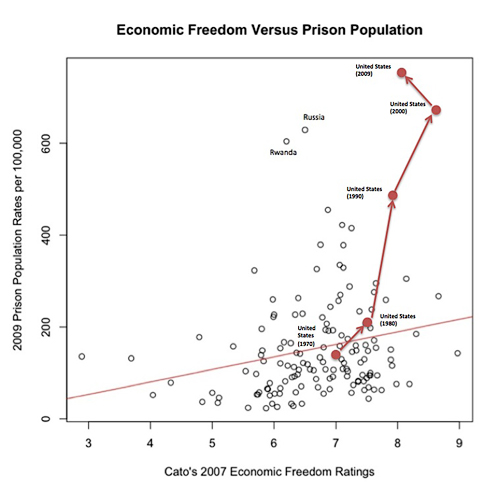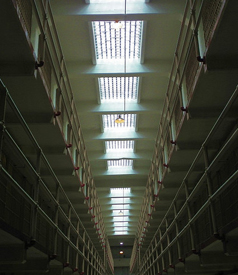Two conservative ideologies are at work behind the huge prison population.
Following Lynn Parramore’s piece on on solitary confinement, it’s important to note that criminal sentencing reform will be on the table in 2011. Collapsing state budgets and ever-increasing prison populations (and the costs associated with them) will force the issue. Republican Indiana Governor Mitch Daniels has recently endorsed a plan to help reduce the prison population.
As this issue unfolds, it is important to understand how we got here in the first place. First, having so much of our population behind bars is a new phenomenon, going back to 1980.

The widespread acceptance of two strains of conservative thought have led to this. The first is the school of thought known as the incapacitation theory, a theory that says, in the words of James Q. Wilson: “Wicked people exist. Nothing avails except to set them apart from innocent people.”
The second is known as the broken windows theory, the idea that a neighborhood could be separated into orderly and disorderly people. As disorder sets in, orderly people flee or retrench from the neighborhood, and new disorderly people are emboldened to enter and take over. It also includes the idea that a police force doesn’t solve crimes but rather maintains order. In this vision, the police don’t investigate and present evidence to a prosecutor, who then presents evidence to a jury.
There’s an important rhetorical trick that the broken window ideology brought to the table, one that caught progressives off guard and brought in liberals hook, line, and sinker. As Bernard Harcourt has noted, it transforms the idea of offensive acts into harmful acts. Public drinking and loitering aren’t harms, but they are offensive to some. Broken windows allowed people to believe that offensive behavior leads to (by creating the potentials for and inevitability of) legal harms. It also became backwards compatible, allowing people to think that harmful acts were obviously preceded by an offensive act; criminalize and ruthlessly prosecute the offensive acts, and you can prevent the real harms from taking place.
It’s worth noting how broken windows, instead of acting as an alternative to incapacitation theory, acted as a supplement. But how did we get to incapacitation in the first place? In the law and economics approach of the Chicago School of Becker, Posner, Coase, etc. it is hard to balance the idea that crime is committed after an estimate of costs and benefits. Risking 30 years in prison to rob a store for $80 can’t really be squared away. So what the incapacitation school argued is that it can’t, unless you consider that criminals have a cognitive makeup that makes them impulsive and “present-orientated.” Wilson makes reference to this in his 1975 book “Thinking About Crime“: “Lower-class persons…immediate gratification…inclined to uninhibited, expressive conduct.” This is the idea that delayed gratification is an essential part of the social contract and that those who are incapable of it are likely to become disorderly and commit crime.
Get Truthout in your inbox every day! Click here to sign up for free updates.
Here’s Edward C. Banfield, a professor of Urban Government at Harvard and the chairman of President Nixon’s task force on the Model Cities Program, who was a mentor to James Q. Wilson:
[T]he many traits that constitute a “patterning” are all consequences, indirect if not direct, of a time horizon that is characteristic of a class… The lower-class individual lives in the slum, which, to a greater or lesser extent, is an expression of his tastes and style of life… [T]he indifference (”apathy” if one prefers) of the lower-class person is such that he seldom makes even the simplest repairs to the place that he lives in. He is not troubled by dirt and dilapidation and he does not mind the inadequacy of public facilities such as schools, parks, hospital, and libraries; indeed, where such things exist he may destroy them by carelessness or even by vandalism… [T]he slum is specialized as [a site] for vice and for illicit commodities generally…
[S]ince the benefits of crime tend to be immediate and its costs (such as imprisonment or loss of reputation) in the future, the present-oriented individual is ipso facto more disposed towards crime than others… The fact is, that no one knows how to change the culture of any part of the population… [T]he policy maker usually must take certain cultural and psychological traits as given… If he is to change a city’s potential for crime it must be by manipulating situational factors, which is to say inducements…either by raising the cost of crime or by raising the benefits of noncrime… [Society must] abridge to an appropriate degree the freedom of those who in the opinion of a court are extremely likely to commit violent crimes. (”Unheavenly City Revisited“, 1974)
[A] cohort of present-oriented persons could as a rule be expected to commit a good many more crimes of certain types than a matched cohort of persons who are not present-oriented. (”Present Orientedness and Crime“, 1991)
There are two things to note about this. The first is that, even if it isn’t self-conscious, this is an appeal to use thicker psychological descriptions in order to supplement economic models. The cost-benefit analysis of why someone would commit an armed robbery doesn’t make sense unless you also assume the robber weighs current gains much more than future losses. In this sense, we would call this “behavioral economics.” It’s ironic, since many assume the turn towards thicker psychological descriptions in economics will naturally lead towards more progressive outcomes. But here a behavioral turn has been used to justify a massive expansion in the punitive aspects of the government alongside a massive buildup in the carceral state apparatus.
The second is that we should all become more familiar with Charles Karelis’ arguments in his excellent book “The Persistence of Poverty“. It’s a slim volume and makes a great afternoon read. Karelis proposes we start to distinguish between pleasure goods and goods that are relievers, and realize that some goods can act as both. His thesis is that there is diminishing marginal utility in pleasure goods, but that relievers have increasing marginal utility. “…[P]aying the first bill in a stack of overdue bills does little to relieve a guilty conscience.”
Karelis takes a moment to do some intellectual history digging and finds that the current economic obsession with decreasing marginal utility comes from Jeremy Bentham equating happiness with the absence of unhappiness. Bentham, as well as the Mills, thought of happiness as reciprocal to unhappiness, like the relationship between tall and short. So increasing happiness is the same as decreasing unhappiness. Maybe, maybe not. But the problem is that this relationship is carried over to the goods that effect happiness and unhappiness.
People in a state of increasing marginal utility will display things that look like pathologies from a more secure footing — binging and not smoothing, low and high extreme work output instead of constant labor — but are perfectly rational given a state where every good has a reliever quality.
I’ll continue in future writing about a new liberal vision of crime and punishment.
Mike Konczal is a Fellow at the Roosevelt Institute.
Join us in defending the truth before it’s too late
The future of independent journalism is uncertain, and the consequences of losing it are too grave to ignore. To ensure Truthout remains safe, strong, and free, we need to raise $46,000 in the next 7 days. Every dollar raised goes directly toward the costs of producing news you can trust.
Please give what you can — because by supporting us with a tax-deductible donation, you’re not just preserving a source of news, you’re helping to safeguard what’s left of our democracy.
